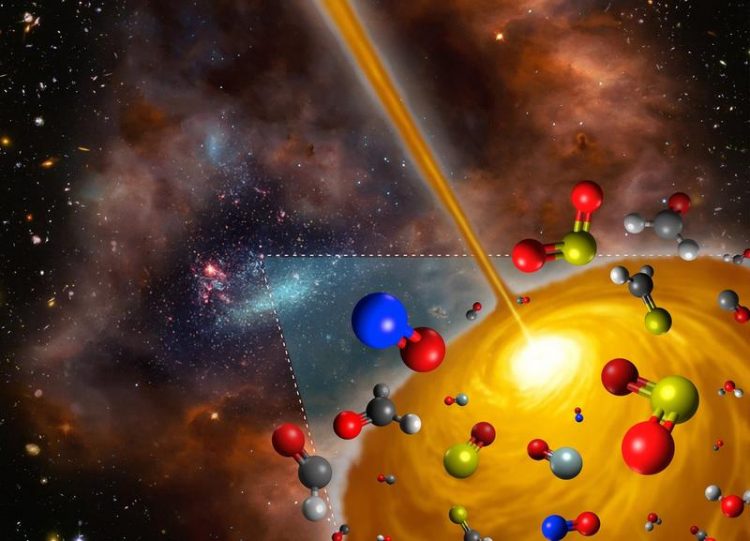Discovery of an Extragalactic Hot Molecular Core

Artist's concept image of the hot molecular core discovered in the Large Magellanic Cloud. Credit: FRIS/Tohoku University. The figure is a derivative work of the following sources (ESO/M. Kornmesser; NASA, ESA, and S. Beckwith (STScI) and the HUDF Team; NASA/ESA and the Hubble Heritage Team (AURA/STScI)/HEI).
The scientists from Tohoku University, the University of Tokyo, the National Astronomical Observatory of Japan, and the University of Tsukuba, used the Atacama Large Millimeter/submillimeter Array (ALMA) in Chile to observe a newborn star located in the Large Magellanic Cloud, one of the closest neighbors of our Galaxy. As a result, a number of radio emission lines from various molecular gas are detected, which indicates the presence of a hot molecular core associated with the observed newborn star (Fig. 1 and 2).
The observations have revealed that the hot molecular core in the Large Magellanic Cloud shows significantly different chemical compositions as compared to similar objects in our Galaxy. In particular, the results suggest that simple organic molecules such as methanol are deficient in this galaxy, suggesting a potential difficulty in producing large organic species indispensable for the birth of life. The research team suggests that the unique galactic environment of the Large Magellanic Cloud affects the formation processes of molecules around a newborn star, and this results in the observed unique chemical compositions.
“This is the first detection of an extragalactic hot molecular core, and it demonstrates the great capability of new generation telescopes to study astrochemical phenomena beyond our Galaxy,” said Dr. Takashi Shimonishi, an astronomer at Tohoku University, Japan, and the paper's lead author. “The observations have suggested that the chemical compositions of materials that form stars and planets are much more diverse than we expected. “
It is known that various complex organic molecules, which have a connection to prebiotic molecules formed in space, are detected from hot molecular cores in our Galaxy. It is, however, not yet clear if such large and complex molecules exist in hot molecular cores in other galaxies. The newly discovered hot molecular core is an excellent target for such a study, and further observations of extragalactic hot molecular cores will shed light on the chemical complexities of our universe.
This work is supported by a Grant-in-Aid from the Japan Society for the Promotion of Science (15K17612).
The Atacama Large Millimeter/submillimeter Array (ALMA), an international astronomy facility, is a partnership of the European Organisation for Astronomical Research in the Southern Hemisphere (ESO), the U.S. National Science Foundation (NSF) and the National Institutes of Natural Sciences (NINS) of Japan in cooperation with the Republic of Chile. ALMA is funded by ESO on behalf of its Member States, by NSF in cooperation with the National Research Council of Canada (NRC) and the National Science Council of Taiwan (NSC) and by NINS in cooperation with the Academia Sinica (AS) in Taiwan and the Korea Astronomy and Space Science Institute (KASI). ALMA construction and operations are led by ESO on behalf of its Member States; by the National Radio Astronomy Observatory (NRAO), managed by Associated Universities, Inc. (AUI), on behalf of North America; and by the National Astronomical Observatory of Japan (NAOJ) on behalf of East Asia. The Joint ALMA Observatory (JAO) provides the unified leadership and management of the construction, commissioning and operation of ALMA.
Full bibliographic informationAuthors: Takashi Shimonishi, Takashi Onaka, Akiko Kawamura, Yuri Aikawa
Title: The Detection of a Hot Molecular Core in the Large Magellanic Cloud with ALMA
Journal: The Astrophysical Journal, 827, 72
DOI: http://dx.doi.org/10.3847/0004-637X/827/1/72
For further information, please contact:
Masaaki Hiramatsu
NAOJ
+81-422-34-3630
Media Contact
More Information:
http://www.nao.ac.jp/E/All latest news from the category: Physics and Astronomy
This area deals with the fundamental laws and building blocks of nature and how they interact, the properties and the behavior of matter, and research into space and time and their structures.
innovations-report provides in-depth reports and articles on subjects such as astrophysics, laser technologies, nuclear, quantum, particle and solid-state physics, nanotechnologies, planetary research and findings (Mars, Venus) and developments related to the Hubble Telescope.
Newest articles

Trotting robots reveal emergence of animal gait transitions
A four-legged robot trained with machine learning by EPFL researchers has learned to avoid falls by spontaneously switching between walking, trotting, and pronking – a milestone for roboticists as well…

Innovation promises to prevent power pole-top fires
Engineers in Australia have found a new way to make power-pole insulators resistant to fire and electrical sparking, promising to prevent dangerous pole-top fires and reduce blackouts. Pole-top fires pose…

Possible alternative to antibiotics produced by bacteria
Antibacterial substance from staphylococci discovered with new mechanism of action against natural competitors. Many bacteria produce substances to gain an advantage over competitors in their highly competitive natural environment. Researchers…





















